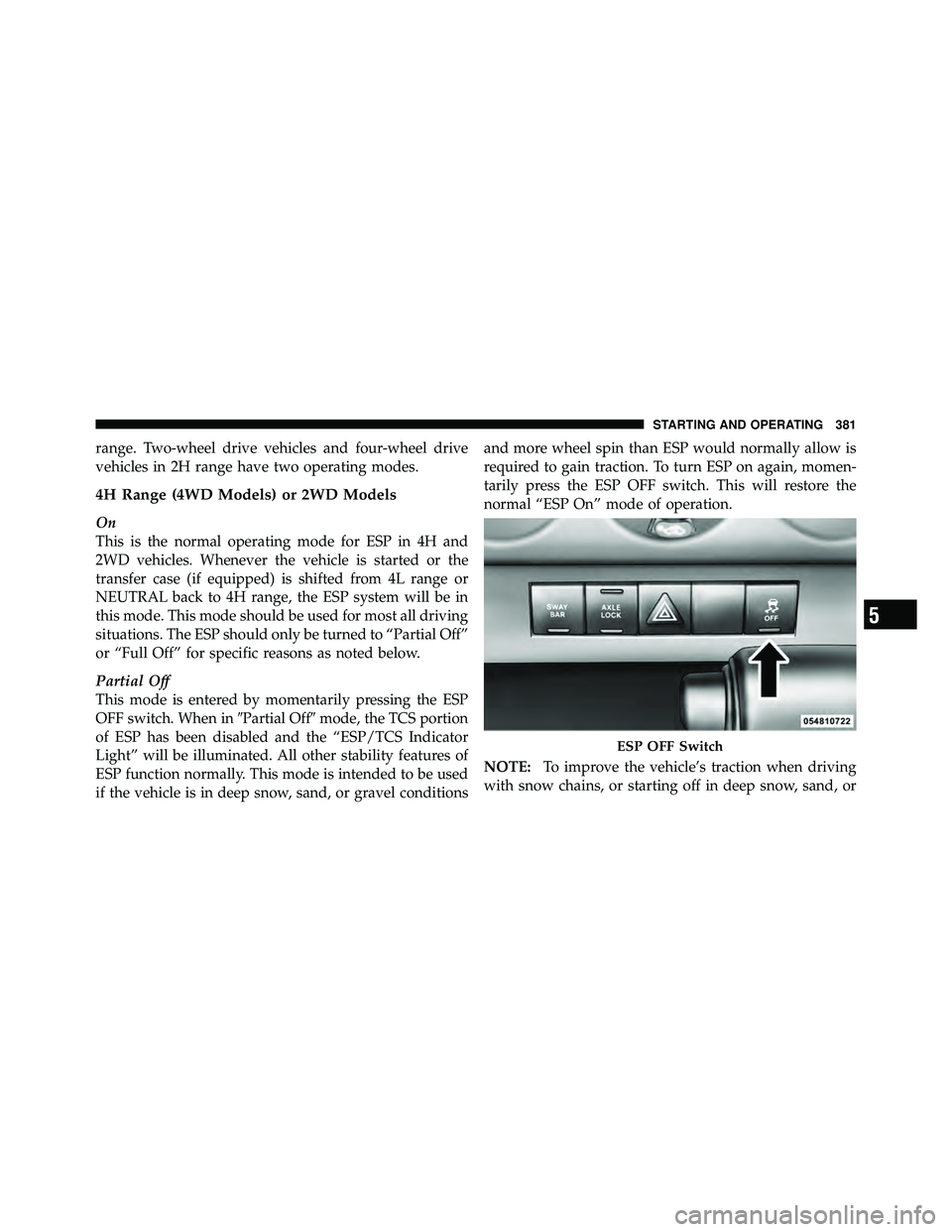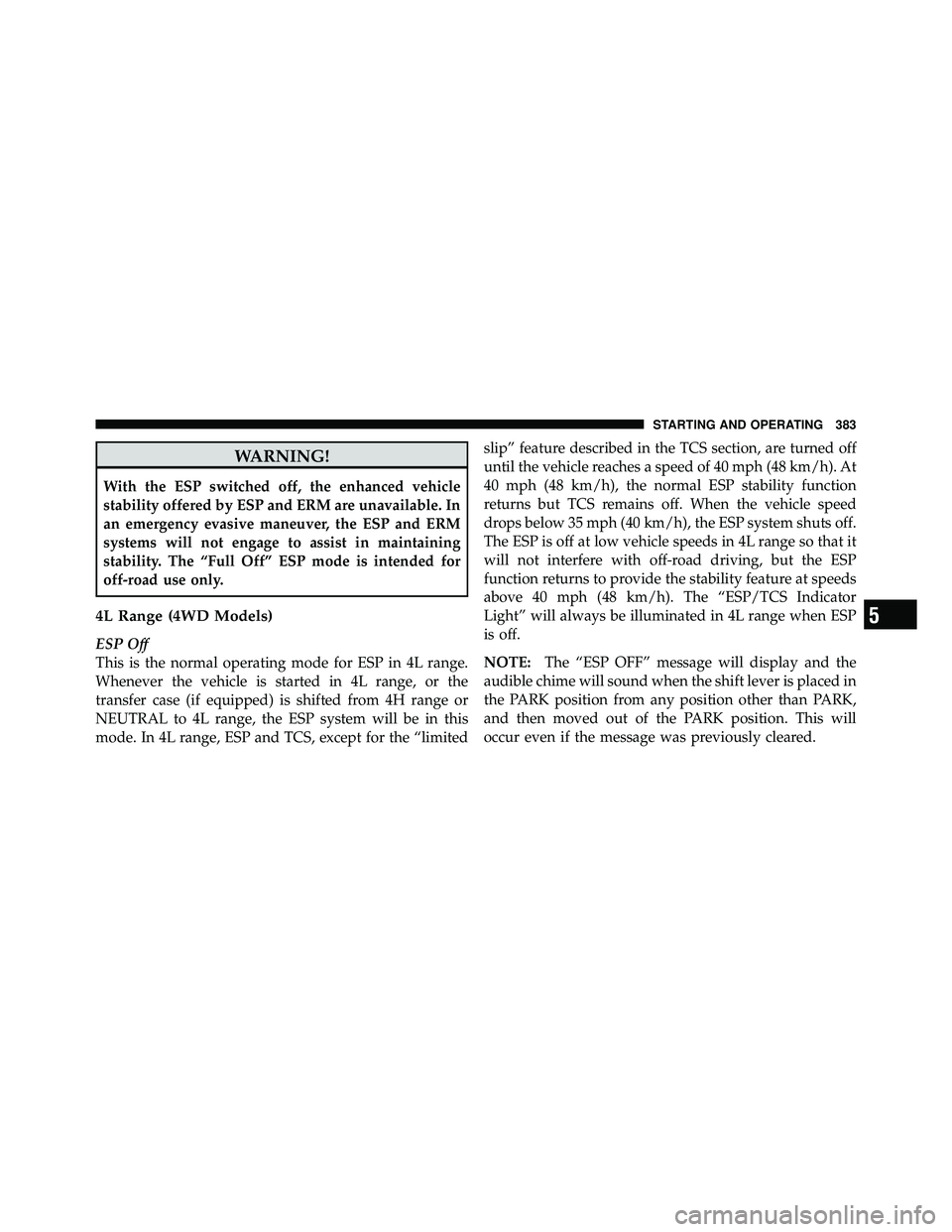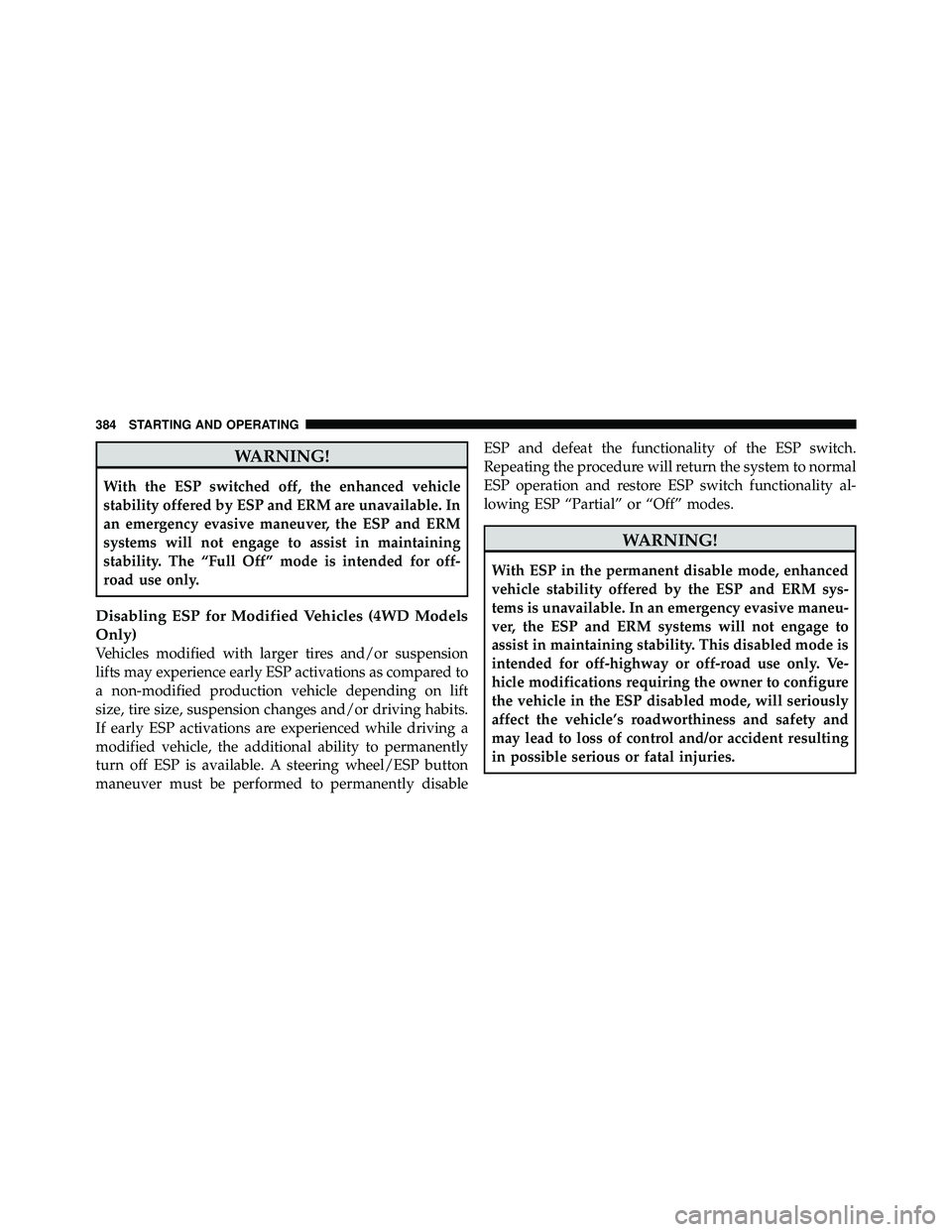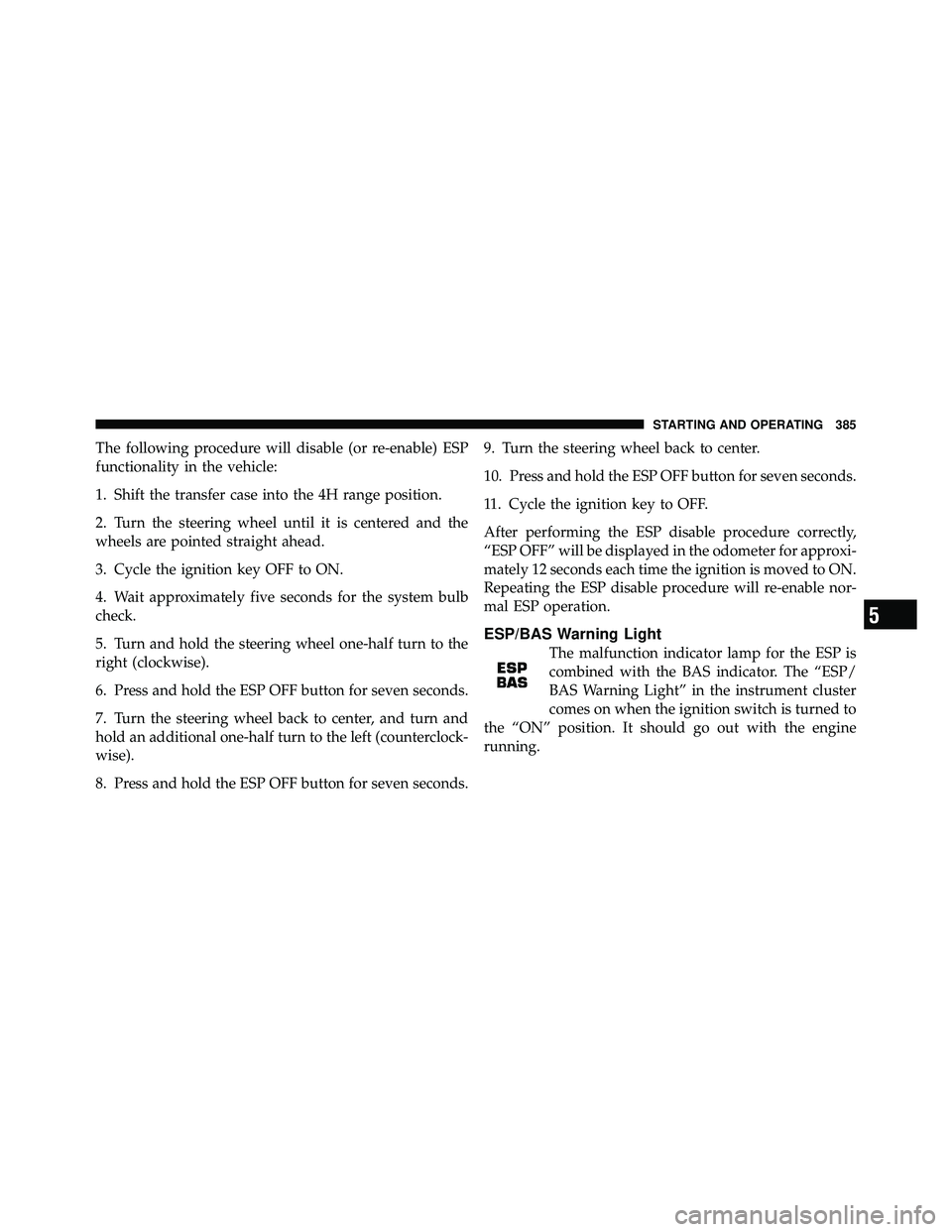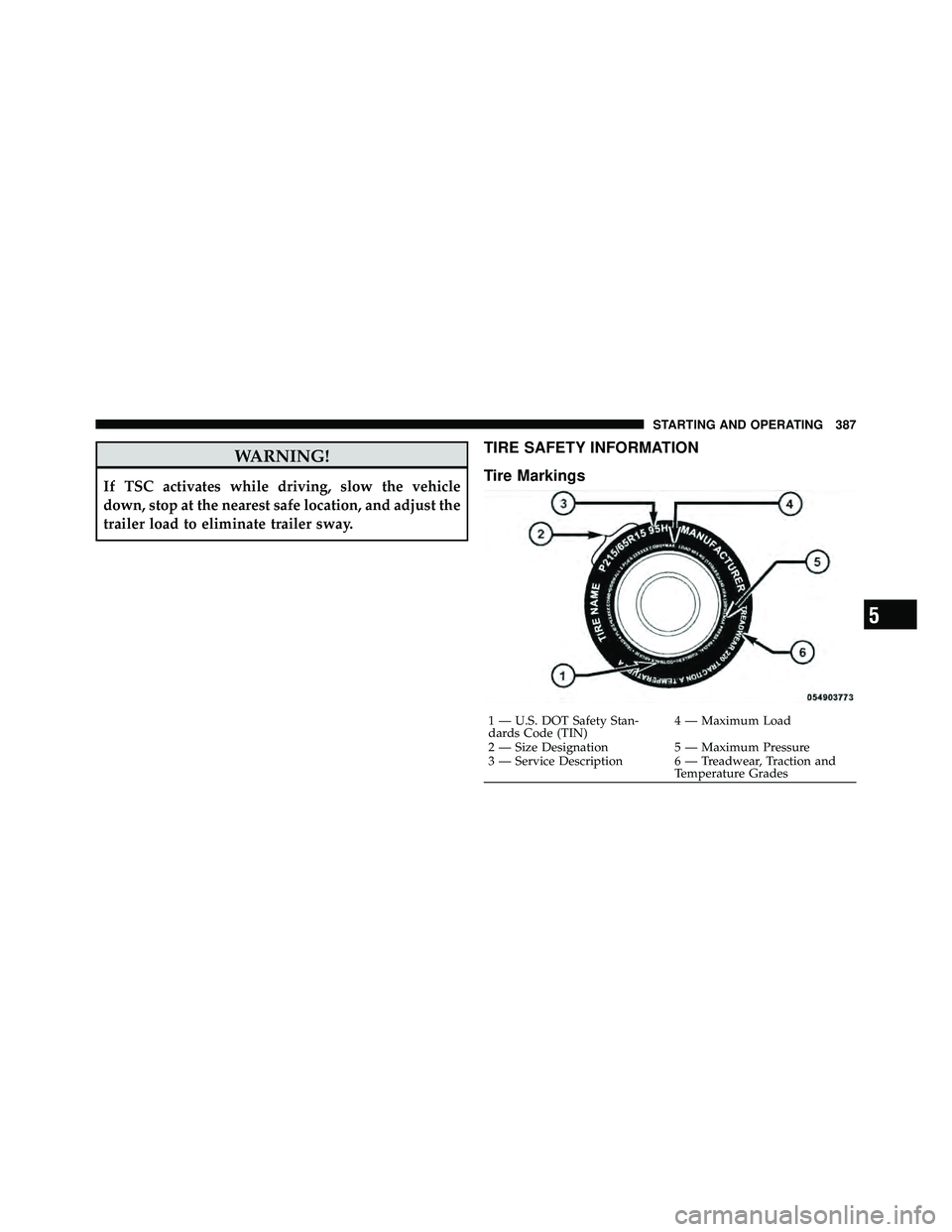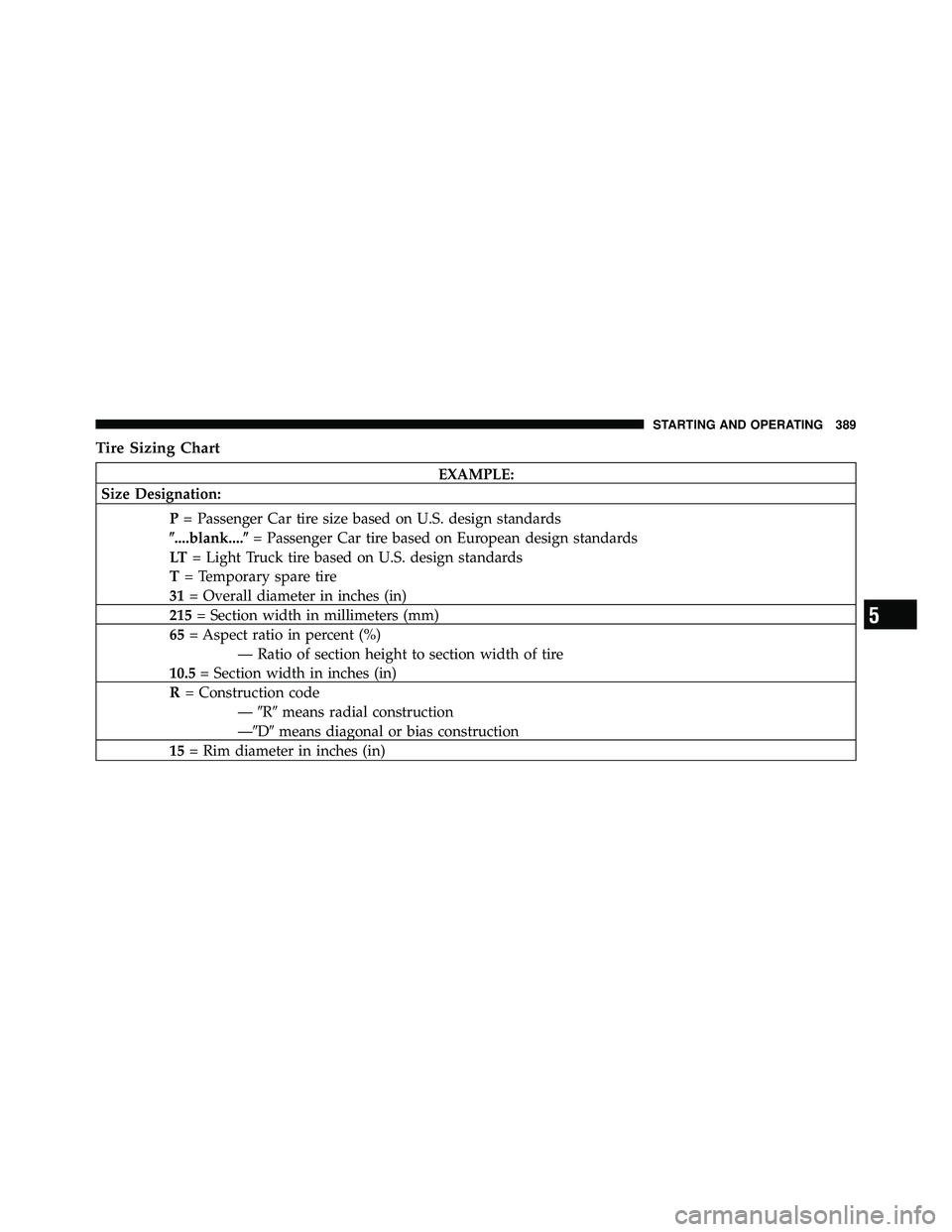JEEP WRANGLER 2010 Owners Manual
WRANGLER 2010
JEEP
JEEP
https://www.carmanualsonline.info/img/16/56059/w960_56059-0.png
JEEP WRANGLER 2010 Owners Manual
Trending: overheating, hood release, height, oil capacities, catalytic converter, oil pressure, tire type
Page 381 of 554
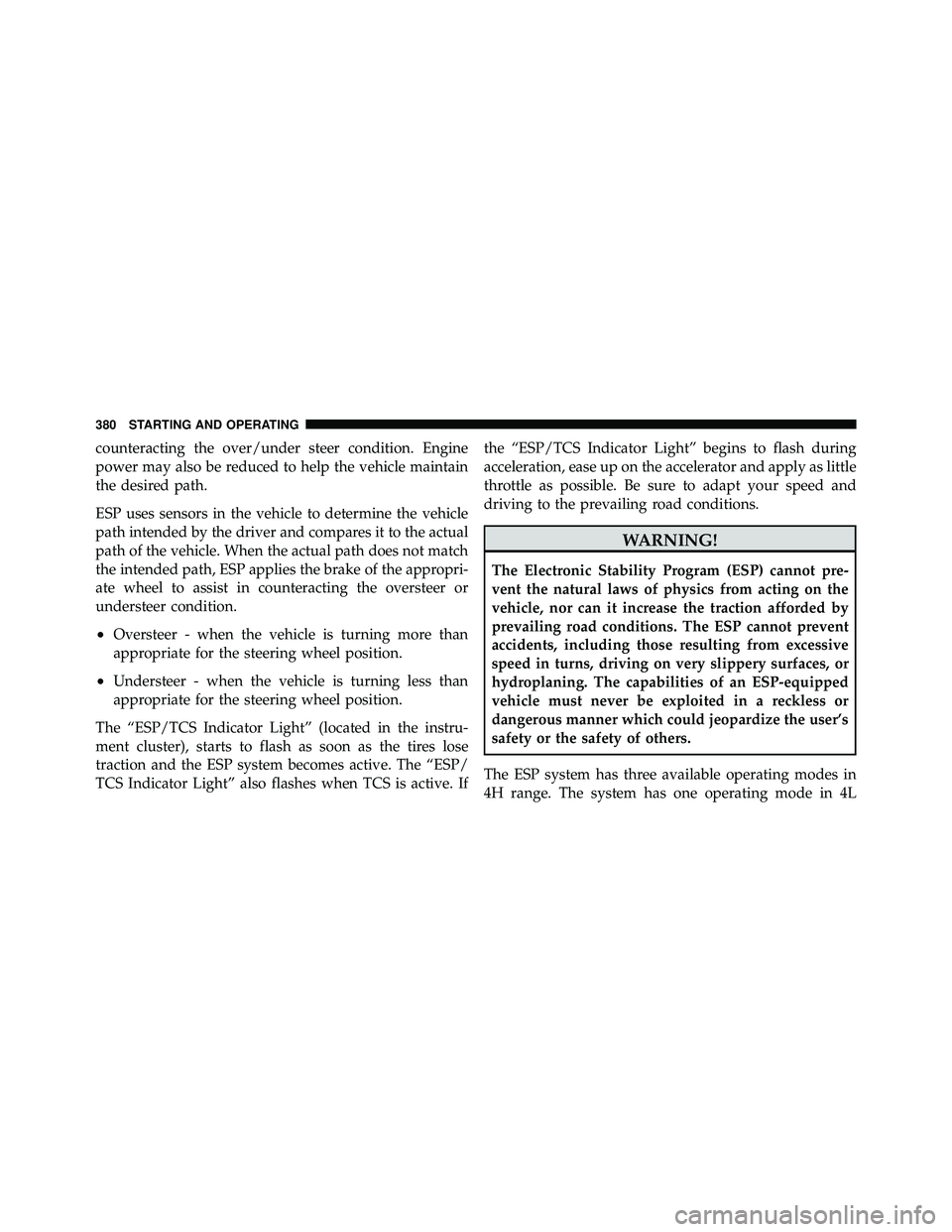
counteracting the over/under steer condition. Engine
power may also be reduced to help the vehicle maintain
the desired path.
ESP uses sensors in the vehicle to determine the vehicle
path intended by the driver and compares it to the actual
path of the vehicle. When the actual path does not match
the intended path, ESP applies the brake of the appropri-
ate wheel to assist in counteracting the oversteer or
understeer condition.
•Oversteer - when the vehicle is turning more than
appropriate for the steering wheel position.
•Understeer - when the vehicle is turning less than
appropriate for the steering wheel position.
The “ESP/TCS Indicator Light” (located in the instru-
ment cluster), starts to flash as soon as the tires lose
traction and the ESP system becomes active. The “ESP/
TCS Indicator Light” also flashes when TCS is active. If the “ESP/TCS Indicator Light” begins to flash during
acceleration, ease up on the accelerator and apply as little
throttle as possible. Be sure to adapt your speed and
driving to the prevailing road conditions.
Page 382 of 554
Page 383 of 554
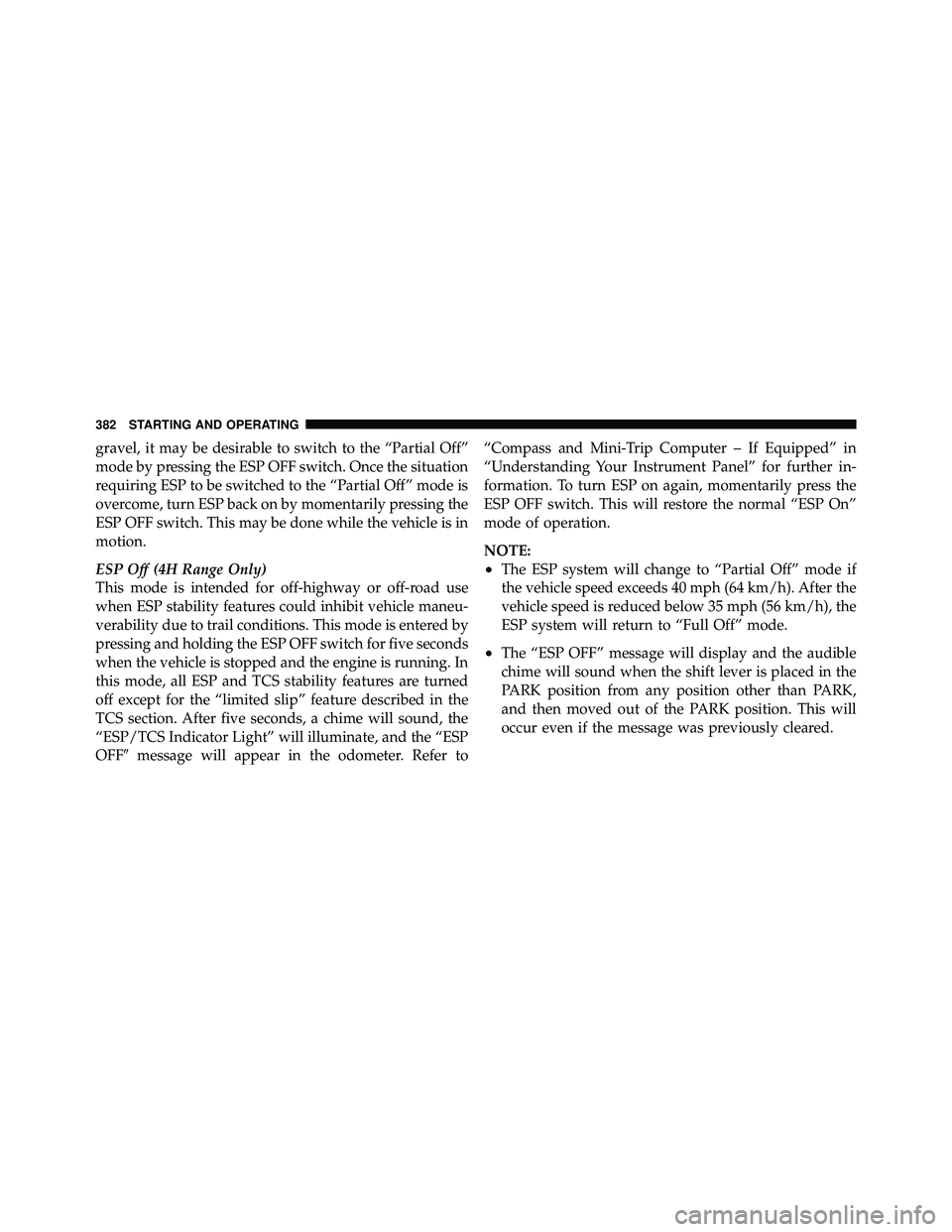
gravel, it may be desirable to switch to the “Partial Off”
mode by pressing the ESP OFF switch. Once the situation
requiring ESP to be switched to the “Partial Off” mode is
overcome, turn ESP back on by momentarily pressing the
ESP OFF switch. This may be done while the vehicle is in
motion.
ESP Off (4H Range Only)
This mode is intended for off-highway or off-road use
when ESP stability features could inhibit vehicle maneu-
verability due to trail conditions. This mode is entered by
pressing and holding the ESP OFF switch for five seconds
when the vehicle is stopped and the engine is running. In
this mode, all ESP and TCS stability features are turned
off except for the “limited slip” feature described in the
TCS section. After five seconds, a chime will sound, the
“ESP/TCS Indicator Light” will illuminate, and the “ESP
OFF�message will appear in the odometer. Refer to “Compass and Mini-Trip Computer – If Equipped” in
“Understanding Your Instrument Panel” for further in-
formation. To turn ESP on again, momentarily press the
ESP OFF switch. This will restore the normal “ESP On”
mode of operation.
NOTE:
•The ESP system will change to “Partial Off” mode if
the vehicle speed exceeds 40 mph (64 km/h). After the
vehicle speed is reduced below 35 mph (56 km/h), the
ESP system will return to “Full Off” mode.
•The “ESP OFF” message will display and the audible
chime will sound when the shift lever is placed in the
PARK position from any position other than PARK,
and then moved out of the PARK position. This will
occur even if the message was previously cleared.
382 STARTING AND OPERATING
Page 384 of 554
Page 385 of 554
WARNING!
With the ESP switched off, the enhanced vehicle
stability offered by ESP and ERM are unavailable. In
an emergency evasive maneuver, the ESP and ERM
systems will not engage to assist in maintaining
stability. The “Full Off” mode is intended for off-
road use only.
Disabling ESP for Modified Vehicles (4WD Models
Only)
Vehicles modified with larger tires and/or suspension
lifts may experience early ESP activations as compared to
a non-modified production vehicle depending on lift
size, tire size, suspension changes and/or driving habits.
If early ESP activations are experienced while driving a
modified vehicle, the additional ability to permanently
turn off ESP is available. A steering wheel/ESP button
maneuver must be performed to permanently disableESP and defeat the functionality of the ESP switch.
Repeating the procedure will return the system to normal
ESP operation and restore ESP switch functionality al-
lowing ESP “Partial” or “Off” modes.
Page 386 of 554
5
STARTING AND OPERATING 385
Page 387 of 554
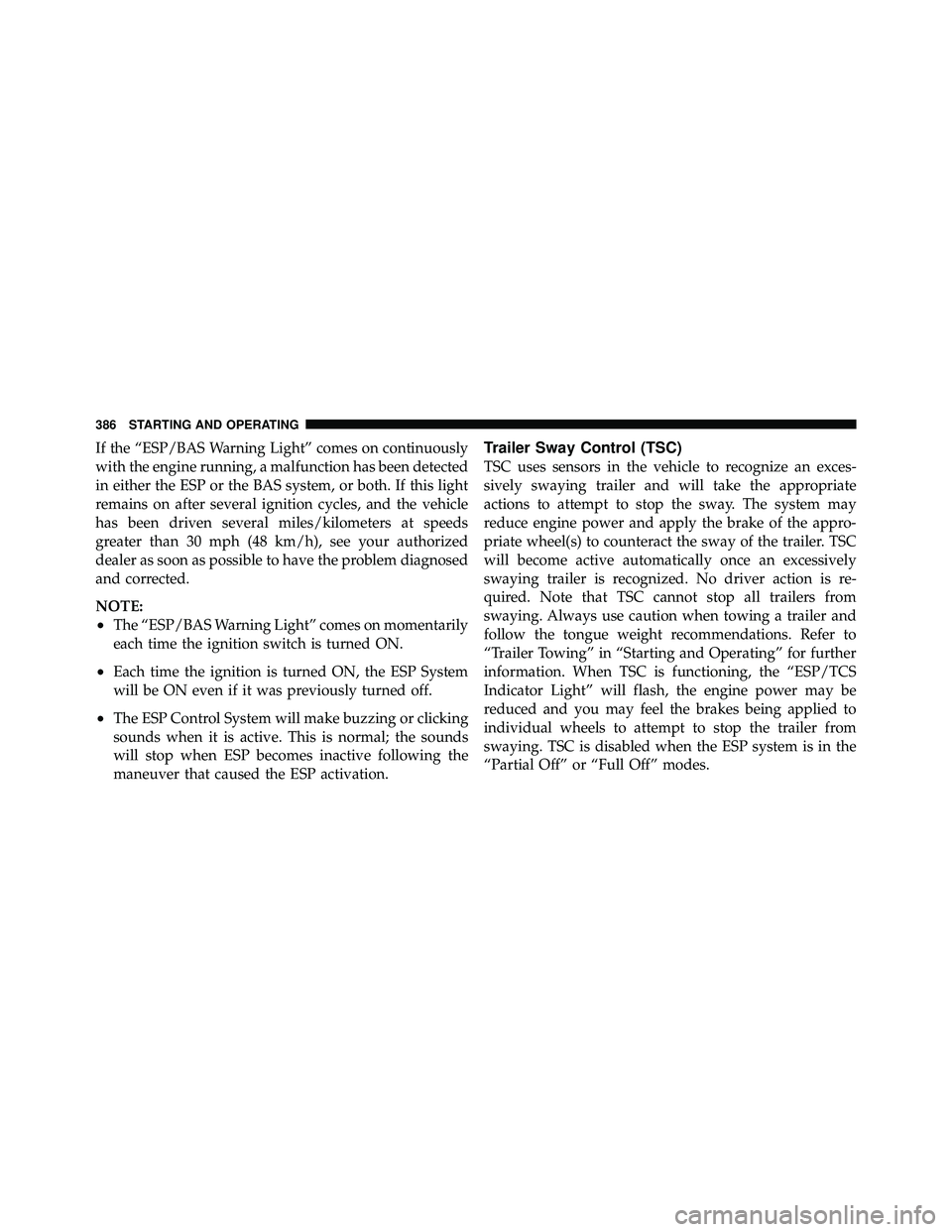
If the “ESP/BAS Warning Light” comes on continuously
with the engine running, a malfunction has been detected
in either the ESP or the BAS system, or both. If this light
remains on after several ignition cycles, and the vehicle
has been driven several miles/kilometers at speeds
greater than 30 mph (48 km/h), see your authorized
dealer as soon as possible to have the problem diagnosed
and corrected.
NOTE:
•The “ESP/BAS Warning Light” comes on momentarily
each time the ignition switch is turned ON.
•Each time the ignition is turned ON, the ESP System
will be ON even if it was previously turned off.
•The ESP Control System will make buzzing or clicking
sounds when it is active. This is normal; the sounds
will stop when ESP becomes inactive following the
maneuver that caused the ESP activation.
Trailer Sway Control (TSC)
TSC uses sensors in the vehicle to recognize an exces-
sively swaying trailer and will take the appropriate
actions to attempt to stop the sway. The system may
reduce engine power and apply the brake of the appro-
priate wheel(s) to counteract the sway of the trailer. TSC
will become active automatically once an excessively
swaying trailer is recognized. No driver action is re-
quired. Note that TSC cannot stop all trailers from
swaying. Always use caution when towing a trailer and
follow the tongue weight recommendations. Refer to
“Trailer Towing” in “Starting and Operating” for further
information. When TSC is functioning, the “ESP/TCS
Indicator Light” will flash, the engine power may be
reduced and you may feel the brakes being applied to
individual wheels to attempt to stop the trailer from
swaying. TSC is disabled when the ESP system is in the
“Partial Off” or “Full Off” modes.
386 STARTING AND OPERATING
Page 388 of 554
Page 389 of 554
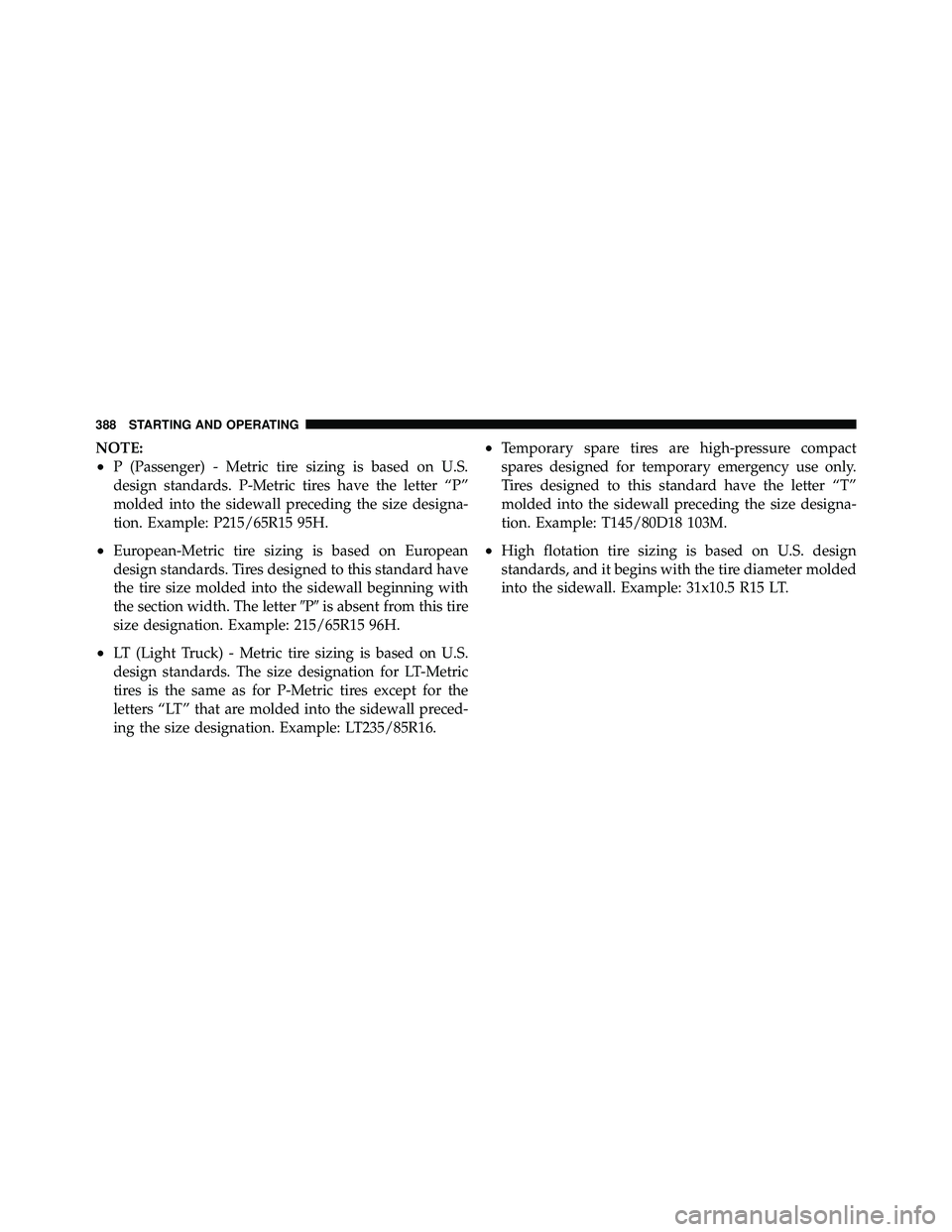
NOTE:
•P (Passenger) - Metric tire sizing is based on U.S.
design standards. P-Metric tires have the letter “P”
molded into the sidewall preceding the size designa-
tion. Example: P215/65R15 95H.
•European-Metric tire sizing is based on European
design standards. Tires designed to this standard have
the tire size molded into the sidewall beginning with
the section width. The letter�P�is absent from this tire
size designation. Example: 215/65R15 96H.
•LT (Light Truck) - Metric tire sizing is based on U.S.
design standards. The size designation for LT-Metric
tires is the same as for P-Metric tires except for the
letters “LT” that are molded into the sidewall preced-
ing the size designation. Example: LT235/85R16.
•Temporary spare tires are high-pressure compact
spares designed for temporary emergency use only.
Tires designed to this standard have the letter “T”
molded into the sidewall preceding the size designa-
tion. Example: T145/80D18 103M.
•High flotation tire sizing is based on U.S. design
standards, and it begins with the tire diameter molded
into the sidewall. Example: 31x10.5 R15 LT.
388 STARTING AND OPERATING
Page 390 of 554
Trending: trip computer, fuel cap release, tire type, mirror controls, adding oil, interior lights, catalytic converter

